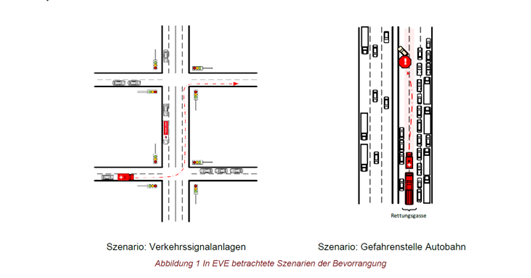Efficient prioritisation of emergency vehicles in automated road traffic
: International standards for Cooperative and Intelligent Transport Systems (C-ITS) are currently being worked on and nearing completion. These standards form the basis of future (emergency-)vehicles with the goal of connectivity and autonomy. The project „Efficient right of way for emergency Vehicles in automatEd traffic“ (EVE) is concerned with the reliable interaction of traffic control signals with connected cars both, in urban as well as interurban areas and in mixed-conventional-connected traffic as well as connected-traffic-only situations.
The project sets out to concretize existing definitions of C-ITS Special Service Permissions for user groups such as emergency services and public transport systems. Through this triaging of user groups at intersections or on highways differently prioritized usage scenarios need to be taken care of by the C-ITS-infrastructure system. Examples for such usage scenarios are the automated right of way for emergency vehicles or the virtual corridor for certain class of traffic.
Through the definition of use cases of the expected behaviour of the traffic infrastructure for different user groups, the project partners can derive and analyse vital requirements for the C-ITS infrastructure. Since C-ITS is a European initiative, all of EVE’s results must not only be seen in the Austrian context but need to be compatible with the whole of Europe to not block cross-border mobility.
EVE develops a Lifecycle Management process and works out processes to securely handle special service permissions based on a public key infrastructure in phases such as issuing, regular use, revocation, and decommissioning. To be able to define a reliable and usable process, EVE takes key aspects such as reliable management of permissions, real-life use, and a comprehensive cyber-security threat analysis with resulting security levels and mitigation requirements into account.
The project will make sure that suggested processes adhere to all legal and operative demands of the operator countries. Already existing security concepts, such as Protection Profiles for infrastructure components, are checked for consistency with the ones defined in the project. Finally, derived security levels are synchronized with existing reference architectures.
- Partner: AIT Austrian Institute of Technology GmbH (Koordinator), Donau-Universität Krems, Bundesministerium für Inneres, Bundesministerium für Landesverteidigung, WIENER LINIEN GmbH & Co KG, ANDATA Entwicklungstechnologie GmbH, Universität Wien, Institut für Europarecht, Internationales Recht und Rechtsvergleichung, Swarco Futurit, Asfinag AG.
- Project duration: 10/2018-03/2021
- Funding: KIRAS Sicherheitsforschung - Ausschreibung 2017/18, Kooperative Projekte




